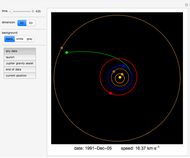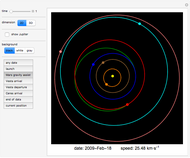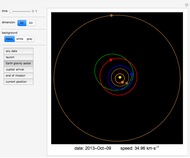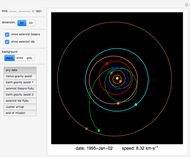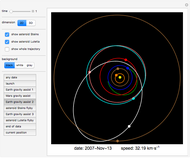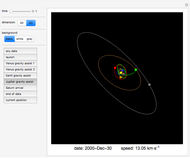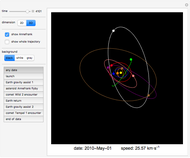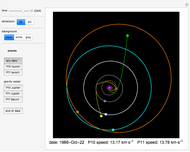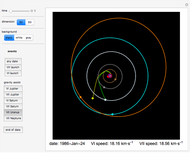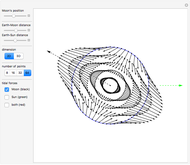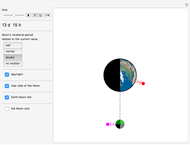Voyager I and II Spaceflight

Requires a Wolfram Notebook System
Interact on desktop, mobile and cloud with the free Wolfram Player or other Wolfram Language products.
This Demonstration shows an animation of the flight of the Voyager I spacecraft's mission to Jupiter and Saturn and the flight of the Voyager II spacecraft's mission to Jupiter, Saturn, Uranus, and Neptune. The Voyager I spacecraft used a technique called gravitational assist with Jupiter and Saturn and the Voyager II spacecraft used this technique four times with Jupiter, Saturn, Uranus, and Neptune.
[more]
Contributed by: Tomas Franc (April 2013)
Open content licensed under CC BY-NC-SA
Snapshots
Details
The time step is one day, positions are at midnight, and the speed is measured relative to the Sun. The origin is at the Sun with the positive  axis pointing toward the vernal equinox.
axis pointing toward the vernal equinox.
Nothing here is modeled; all positions of the spacecraft and planets were obtained from NASA JPL. We thank NASA JPL for providing the data.
Information about the missions can be found on NASA's Voyager website.
More information about the gravitational assist can be found in [1]. A manual on how to create such an animation can be found in [2]. For more information, see the author's website.
On the author's websitethere is a full animation up to the year 2020.
References
[1] T. Franc, "The Gravitational Assist," in Week of Doctoral Students 2011—Proceedings of Contributed Papers: Part III—Physics (WDS 2011), Prague (J. Safrankova and J. Pavlu, eds.), Prague: MatfyzPress Publishing House, 2011 pp. 55–60. www.mff.cuni.cz/veda/konference/wds/proc/pdf11/WDS11_309_f12 _Franc.pdf.
[2] T. Franc, "Gravitational Assisted Trajectories—Making Your Own Pictures and Trajectory Study," in Proceedings GIREP-EPEC Conference 2011, Physics Alive, Jyväskylä, Finland (A. Lindell, A. Kähkönen, and J. Viiri, eds.), Jyväskylä, Finland: University of Jyväskylä, 2011 pp. 202–207. www.jyu.fi/en/congress/girep2011/main-page/electronic-proceedings-of-the-girep-epec-2011-conference.pdf.
Permanent Citation








